1. Indian culture and traditions
Indian culture and traditions and religions represent a rich and diverse tapestry woven through millennia of history, culture, and philosophy. At the heart of this tapestry is Hinduism, one of the oldest religions in the world, characterized by its vast array of beliefs, rituals, and deities. Hinduism is not a monolithic faith; rather, it encompasses a myriad of practices and philosophies, from devotion to specific gods and goddesses to profound philosophical inquiries found in ancient texts like the Vedas and the Upanishads. Central to Hindu thought are concepts like dharma (duty), karma (the law of cause and effect), and moksha (liberation from the cycle of birth and rebirth).
Buddhism, which emerged in the 5th century BCE with the teachings of Siddhartha Gautama, known as the Buddha, introduces a different approach. It focuses on the path to enlightenment through understanding the nature of suffering and practicing the Eightfold Path. The Four Noble Truths form the foundation of Buddhist teaching, emphasizing the impermanence of life and the importance of mindfulness.
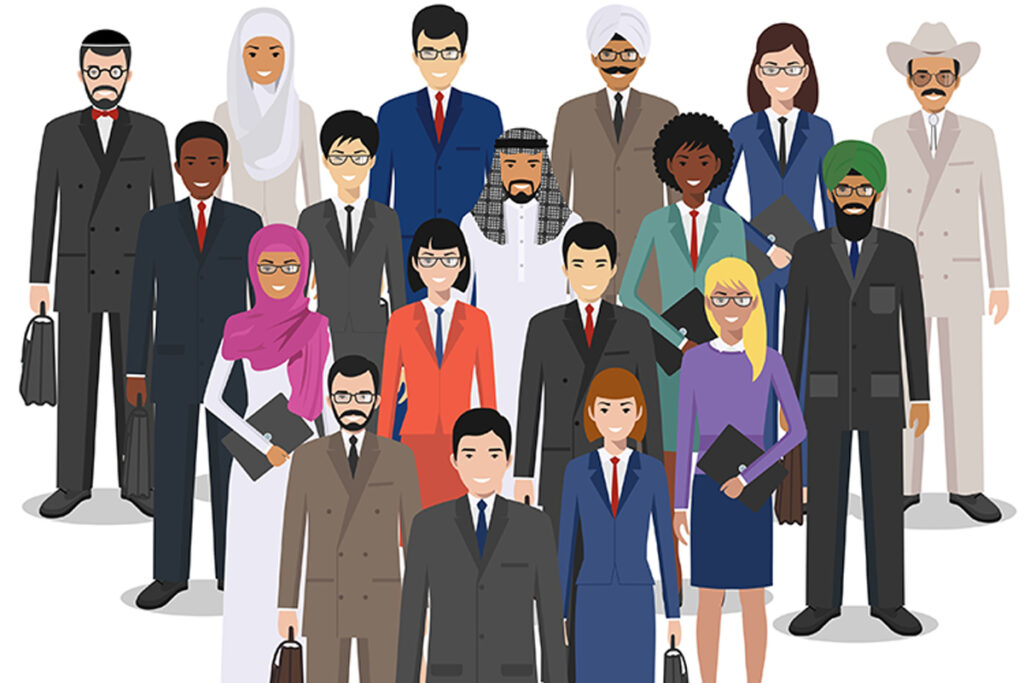
Jainism, another ancient tradition, shares some philosophical roots with Hinduism and Buddhism but is distinct in its staunch emphasis on non-violence (ahimsa) and truth (satya). Jains believe in the liberation of the soul through strict ethical conduct and ascetic practices.
Sikhism, founded in the 15th century by Guru Nanak, arose in the context of a diverse religious landscape. It emphasizes the oneness of God, equality among all people, and selfless service to others. The teachings of the Sikh Gurus, recorded in the Guru Granth Sahib, guide followers in their spiritual and communal lives.
In addition to these major religions, Indian culture and traditions is home to Zoroastrianism, primarily represented by the Parsi community, as well as significant populations of Christians and Muslims. Christianity arrived through early missionaries, while Islam came with traders and conquerors, enriching the cultural and spiritual landscape of India. Each of these faiths brings its own teachings, rituals, and festivals, contributing to the vibrant mosaic of Indian culture and traditions life.
Festivals like Diwali, Eid, Christmas, and Vaisakhi celebrate the diverse beliefs and traditions, serving as moments of joy and community gathering. These religious practices also deeply influence art, music, dance, and architecture, evident in the stunning temples, mosques, and churches that dot the Indian subcontinent.
The interplay of these religions creates a dynamic cultural environment, fostering dialogue and sometimes tension, but also a profound sense of shared humanity. The spiritual and philosophical legacies of Indian religions continue to resonate, shaping not only the lives of millions within India but also influencing global thought and practice.
2. Greeting
When you meet someone in India, a warm “Namaste” is often the best way to start. This greeting in Indian culture and traditions involves bringing your palms together and bowing slightly, conveying respect and openness. In the northern regions, you might hear “Ram Ram,” which carries a spiritual essence, especially among Hindus.
If you’re chatting with friends, a casual “Kya haal hai?” or “Sab theek hai?” works perfectly to ask how they are. For a more formal touch, you could say “Aap kaise hain?” which shows respect while inquiring about their well-being.
During festive seasons, greetings take on special meanings. For Diwali, you might wish someone “Diwali ki shubhkamnayein!” or celebrate Eid with a heartfelt “Eid Mubarak!” Each festival brings its own unique flavor to greetings, making them even more meaningful.
When parting ways, a simple “Shubh ratri” (Good night) or “Shubh prabhat” (Good morning) wraps up the conversation nicely. These greetings reflect the warmth and hospitality deeply rooted in Indian culture, making every interaction feel special.
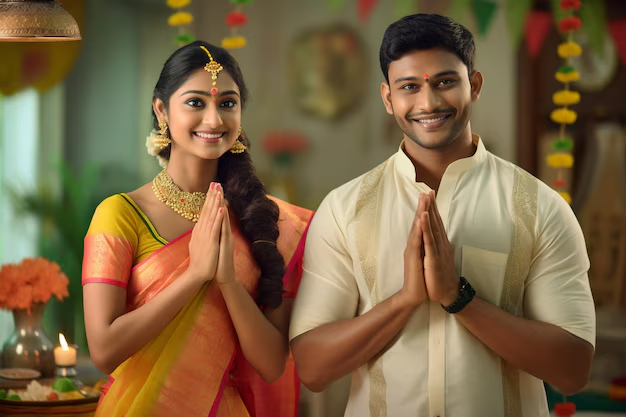
3. Indian Families
When you meet someone in India, a warm “Namaste” is often the best way to start. This greeting involves in Indian culture and traditions bringing your palms together and bowing slightly, conveying respect and openness. In the northern regions, you might hear “Ram Ram,” which carries a spiritual essence, especially among Hindus.
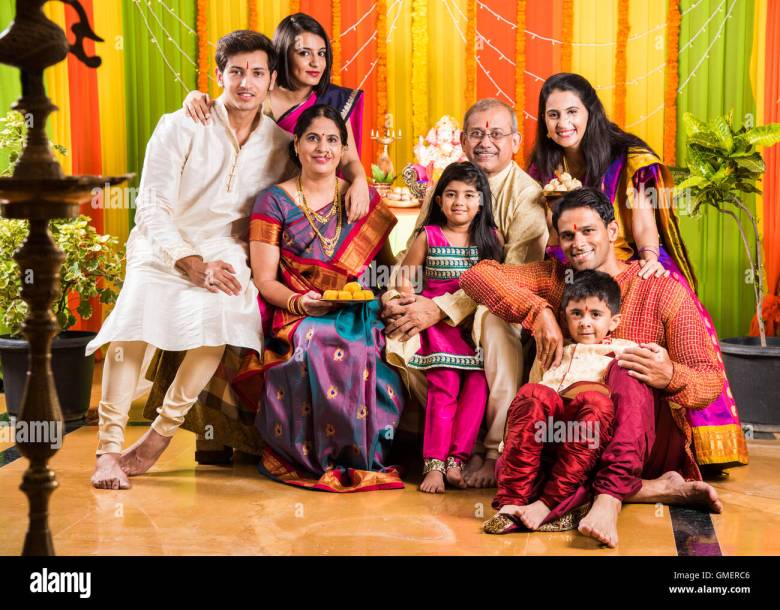
If you’re chatting with friends, a casual “Kya haal hai?” or “Sab theek hai?” works perfectly to ask how they are. For a more formal touch, you could say “Aap kaise hain?” which shows respect while inquiring about their well-being.
During festive seasons, greetings take on special meanings. For Diwali, you might wish someone “Diwali ki shubhkamnayein!” or celebrate Eid with a heartfelt “Eid Mubarak!” Each festival brings its own unique flavor to greetings, making them even more meaningful.
When parting ways, a simple “Shubh ratri” (Good night) or “Shubh prabhat” (Good morning) wraps up the conversation nicely. These greetings reflect the warmth and hospitality deeply rooted in Indian culture, making every interaction feel special.
4. Indian Food
The Rich Tapestry of Indian Cuisine
Indian culture and traditions food is a vibrant celebration of flavors, colors, and traditions, reflecting the country’s incredible diversity. With a history that spans thousands of years, Indian cuisine has evolved through the influences of various cultures, climates, and regions. Each dish carries a story, often rooted in the traditions of the people who prepare it.
At the heart of Indian cuisine is the concept of sharing. Meals are often communal experiences, bringing families and friends together around the table. In many households, cooking is a cherished ritual, passed down through generations. Recipes are not just written instructions; they are memories infused with love, laughter, and family history.
The diversity of Indian culture and traditions food is astonishing. In the north, the cuisine is characterized by rich, creamy dishes, with favorites like butter chicken and paneer tikka masala. The use of aromatic spices like garam masala, cumin, and coriander creates a depth of flavor that is distinctive to the region. Accompanying these dishes are various types of bread, such as naan and roti, which are often cooked in a traditional clay oven known as a tandoor.
Traveling south, the cuisine shifts dramatically. Here, rice reigns supreme, forming the base of almost every meal. Dishes like dosa—a fermented rice and lentil crepe—and idli, a steamed rice cake, showcase the region’s love for rice. Coconut and curry leaves are commonly used, adding a fresh and aromatic touch to many dishes. The famous sambar, a spicy lentil stew, is often served with these staples, creating a harmonious balance of flavors.
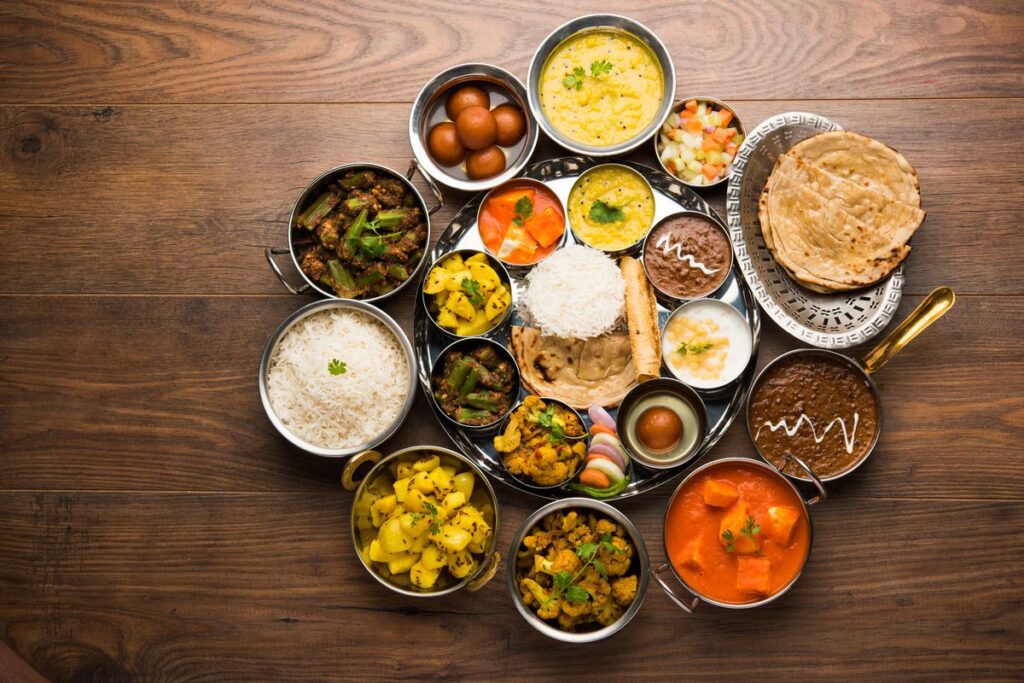
In the eastern parts of India, seafood takes center stage. The coastal states are known for their delicious fish curries, like macher jhol, which highlight the region’s connection to the sea. Sweets also play a significant role in Eastern cuisine, with desserts like rasgulla and sandesh, made from fresh cheese, tantalizing the taste buds and celebrating special occasions.
Western India offers a remarkable blend of flavors, ranging from the vegetarian delights of Gujarat to the spicy, seafood-rich dishes of Maharashtra. Street food here is particularly vibrant, with options like vada pav and pav bhaji captivating the taste buds of locals and visitors alike. The use of spices and herbs creates dishes that are both flavorful and aromatic, with a culinary legacy that reflects the region’s rich history.
The preparation of Indian culture and traditions food is an art form in itself. Techniques vary widely, from slow-cooking curries to ensure that flavors meld perfectly, to the quick tempering of spices in hot oil to release their essential oils. Tadka, or tempering, is a technique used to enhance the flavors of dals and vegetable dishes, where spices are added to sizzling oil or ghee, creating a fragrant base for cooking.
Beyond just the food itself, Indian culture and traditions cuisine is a tapestry woven with cultural significance. Festivals are celebrated with a plethora of special dishes, each holding meaning. For example, during Diwali, the Festival of Lights, families prepare sweets like ladoos and barfis, sharing them with loved ones to symbolize joy and togetherness. Similarly, Eid brings forth a feast of biryani and sweet vermicelli, reflecting the spirit of sharing and community.
Street food adds another layer to the culinary experience in India. Vibrant stalls line the streets, offering quick bites that are bursting with flavor. Chaat, a tantalizing mix of potatoes, chickpeas, and tangy chutneys, is a favorite among many. Pani puri, with its crispy shells filled with spicy water, is a beloved snack that excites the senses. Each region boasts its own street food specialties, showcasing local ingredients and flavors.
In Indian culture and traditions kitchens, food is infused with love and tradition. Meals are often a medley of colors and textures, with an emphasis on balancing flavors—sweet, salty, spicy, and tangy. It’s not just about satisfying hunger; it’s about nourishing the soul and creating lasting memories around the dining table.
5. Indian Festivals
Indian culture and traditions is a land of vibrant festivals, each brimming with rich traditions, cultural significance, and a sense of community. One of the most celebrated is Diwali, often referred to as the Festival of Lights. This joyous occasion marks the triumph of light over darkness and good over evil, symbolized by the return of Lord Rama to Ayodhya after defeating the demon king Ravana. During Diwali, homes are adorned with diyas (oil lamps) and colorful rangoli patterns. Families come together to share sweets, light fireworks, and partake in rituals that foster a spirit of togetherness and hope for the future.
As the season transitions, Holi, the Festival of Colors, brings with it a celebration of love, joy, and the arrival of spring. This festival is marked by people throwing vibrant colored powders at each other, dancing, singing, and enjoying festive foods. It’s a time when barriers fade away, and everyone, regardless of age or background, joins in the exuberant celebrations.
Eid al-Fitr is another significant occasion, celebrated by the Muslim community at the end of Ramadan. This festival is a time for gratitude, reflection, and community bonding. Families gather for special prayers, enjoy delicious feasts, and share sweet treats like sewaiyan, symbolizing the joy of togetherness and generosity.
In the northern and western parts of India, Navratri is celebrated with great fervor. This nine-night festival honors the goddess Durga and culminates in Dussehra, which symbolizes the victory of good over evil through the tales of Lord Rama. The nights are filled with traditional dances like Garba and Dandiya, bringing communities together in a celebration of faith and culture.

In the southern states, Pongal and Makar Sankranti mark the harvest season, expressing gratitude for the bountiful crops. Pongal, particularly celebrated in Tamil Nadu, involves cooking a special dish also called Pongal and decorating homes with intricate kolam designs made from rice flour. Makar Sankranti is known for its kite flying, uniting families in playful competition and festive spirit.
Raksha Bandhan is a heartfelt celebration of the bond between brothers and sisters. Sisters tie a protective thread, or rakhi, around their brothers’ wrists, and in return, brothers pledge to protect them and often give gifts, reinforcing familial love and support.
Janmashtami celebrates the birth of Lord Krishna, an avatar of Vishnu. The festivities include fasting, singing devotional songs, and playful reenactments of Krishna’s life. The highlight is the Dahi Handi event, where teams compete to break a pot of curd, echoing Krishna’s childhood exploits.
Even Christmas, celebrated by Christians across the country, adds to this mosaic of festivals. Families come together for midnight mass, decorate Christmas trees, and prepare a variety of festive dishes, symbolizing joy, goodwill, and the spirit of giving.
Each festival in India tells a story, reflecting the country’s diverse Indian cultures and traditions. They foster a sense of belonging and community, reminding everyone of the beauty in togetherness and celebration.
6. Indian clothing
Indian culture and traditions clothing is a vibrant and diverse reflection of the country’s rich cultural heritage. Traditional attire varies widely across regions, with each garment embodying unique styles, fabrics, and significance.
The saree, for instance, is a timeless piece that consists of a long length of fabric, typically draped elegantly around the body. Depending on the region, the draping style can vary, showcasing the artistry of local traditions. Sarees come in an array of materials, from luxurious silk to breathable cotton, often adorned with intricate embroidery or patterns that tell their own stories.
Another popular ensemble is the salwar kameez, which features a tunic paired with loose trousers. This outfit has gained immense popularity, particularly in northern India, and is frequently complemented by a dupatta, or scarf. The designs can be simple or heavily embellished, suitable for both everyday wear and festive occasions.
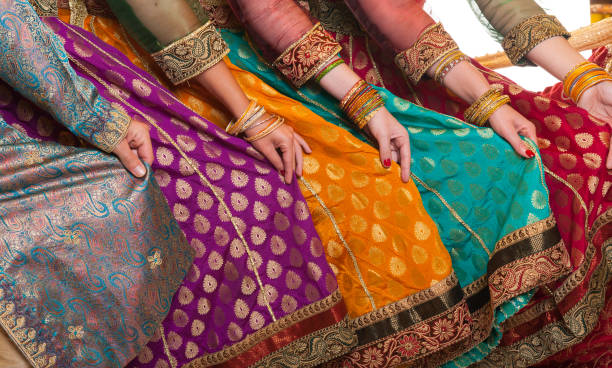
For celebrations, the lehenga choli stands out as a favorite, especially at weddings and festivals. This outfit consists of a flowing skirt paired with a fitted blouse and a dupatta, often intricately embroidered with vibrant colors and patterns.
Men’s attire includes the kurta pajama, a comfortable combination of a long tunic and loose-fitting trousers, often worn during festive occasions. The dhoti, a traditional garment, involves wrapping a length of cloth around the waist, typically paired with a kurta.
In contemporary fashion, there’s a rising trend towards fusion wear, where traditional garments are blended with modern styles. For instance, a saree might be paired with a contemporary top or jacket, creating a unique look that celebrates both heritage and modernity.
The choice of fabric also plays a crucial role in Indian culture and traditions clothing. Silk is often reserved for formal wear, while cotton is favored for its comfort in everyday life. Embroidery styles like Chikan from Lucknow or Zardozi, which uses metallic threads, add a luxurious touch to many garments, particularly for special occasions.
Ultimately, Indian clothing is more than just fabric; it is a vibrant expression of identity, culture, and artistry, deeply intertwined with the country’s festivals, rituals, and celebrations. Each piece tells a story, connecting wearers to their heritage and the rich indian culture and traditions that continue to thrive.
7. Indian languanges
Indian culture and traditions are home to a rich tapestry of languages and dialects, with 22 officially recognized languages and hundreds more spoken across the country. Each language carries its own cultural heritage, literature, and unique expressions.
For example, Hindi, the most widely spoken language, is often used in Bollywood films and popular music, while languages like Tamil and Bengali have rich literary traditions, with poetry and prose that reflect their histories and philosophies.
Regional languages like Gujarati, Marathi, and Kannada also play a vital role in local identity and culture, with vibrant folk traditions, festivals, and culinary arts closely tied to the language spoken.
The diversity of Indian culture and traditions languages not only showcases the country’s cultural richness but also highlights the importance of preserving and promoting these languages in an increasingly globalized world. Efforts to encourage bilingualism and the use of regional languages in education and media are essential for keeping this linguistic heritage alive.

8. Indian Dance
Indian culture and traditions dance is a vibrant tapestry of art forms that reflects the country’s diverse indian culture and traditions. With deep historical roots, these dances often intertwine storytelling, spirituality, and social expression.
One of the most celebrated classical dance forms is Bharatanatyam, which originated in Tamil Nadu. This dance is characterized by its graceful movements, intricate footwork, and expressive hand gestures known as mudras. Performers often depict themes from Hindu mythology, using their bodies to tell stories that resonate with audiences on a spiritual level.
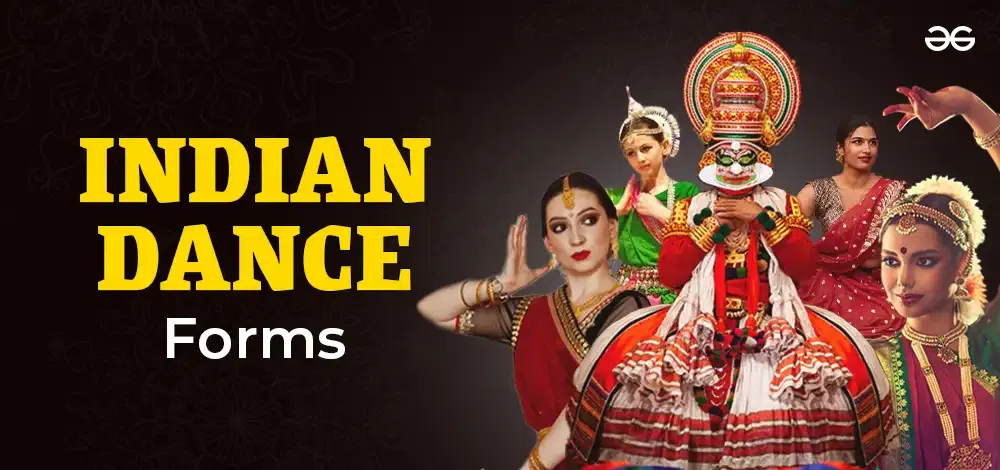
Kathak, another classical style, comes from North India and is distinct for its dynamic footwork and dramatic spins. The dancers often engage in storytelling, drawing from the rich narratives of the Mahabharata and Ramayana. The expressive facial gestures and intricate movements create a captivating experience, inviting the audience into a world of emotion and lore.
Odissi, from Odisha, brings a different flavor with its fluid, graceful movements and poses that resemble sculptures. This dance emphasizes spirituality, often performed in temples as a form of devotion. Each movement is imbued with deep meaning, making it not just a performance, but a form of worship.
Folk dances, like Bhangra and Garba, celebrate the vibrancy of community life. Bhangra, originating from Punjab, is an energetic dance that exudes joy and festivity, often performed during harvest celebrations. Garba, from Gujarat, features circular movements and rhythmic clapping, creating a sense of unity and joy, especially during the Navratri festival.
Contemporary Indian culture and traditions of dance has also evolved, blending traditional styles with modern elements. Fusion dance showcases the dynamic nature of Indian culture and traditions, incorporating Bollywood styles, hip-hop, and even contemporary ballet. This evolution keeps the art form fresh and relevant, appealing to newer generations while honoring its roots.
Costumes in Indian dance are as diverse as the forms themselves, often reflecting the culture and history of the region. From the elaborate sarees of Bharatanatyam dancers to the vibrant attire of folk dancers, each costume enhances the visual storytelling. The music accompanying these dances varies widely, featuring traditional instruments like the tabla, sitar, and flute, which add depth and rhythm to the performances.
Learning Indian dance is often rooted in the traditional guru-shishya parampara, where knowledge is passed down from teacher to student. This relationship fosters a deep connection to the art form, ensuring its preservation and evolution.
conclusion
Indian culture and tradition are a rich tapestry woven from diverse influences, histories, and practices. They encompass a wide range of customs, festivals, art forms, and philosophies that reflect the country’s deep-rooted values of harmony, spirituality, and community. The resilience and adaptability of Indian culture and traditions ensure their continued relevance in a rapidly changing world. As globalization increases, the fusion of traditional and modern elements presents both challenges and opportunities for preserving cultural identity. Ultimately, the essence of Indian culture lies in its ability to celebrate diversity while fostering unity, making it a unique and invaluable part of the global heritage.